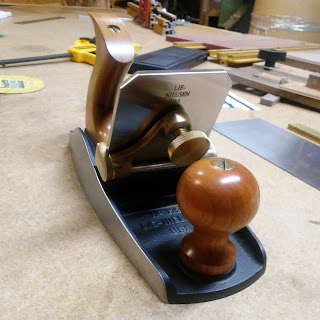The first is a "Poggio virginal," an instrument from the Russell Collection currently residing in Edinburgh, Scotland. It's a wonderful instrument with resonant depth and beauty that's hard to describe here except with a few photos.
I even played it a bit! I've not talked about it here, but I'm very, very hesitant to play before other human beings. Playing is my thing, one that I will rarely, if ever, share with others. I know, it's weird. But the playing and interpretation of music is something that's intensely personal and I feel I already share so much of myself on this blog that I get to keep the playing for myself. Of course, my wife, Tonya, probably feels differently about this - she must endure my practicing.
The other instrument Owen is currently working on is a Donzelague, a larger instrument from the 18th century.
Owen and I discussed a wide range of topics. We covered building techniques, including keyboard construction, register slot cutting (an obvious choice), and jack making and he held a short sharpening clinic for me, as I brought the new planes (described below) along for the ride. It's always great seeing Owen. Not only do I learn a lot about building with every visit, Owen has a quick and inquiring mind and we end up talking about all kinds of interesting subjects.
Owen loaned me a table saw blade he had made by a local (Salem, Oregon) company. It will cut the registers with perfect precision. In fact, I emailed Mr. Miller about a discovery I made with the CAD drawings and he detailed a better way to go about cutting the register slots that aligns with the method described to me by Owen - and Master Builder Michael Peter Johnson on Facebook a couple of weeks ago. In the end, I'll be making a jig that attaches to the Incra miter gauge/cross cut sled that will allow me to cut them perfectly so I can get on with things. More to come as I work this out.
There have been several shop tool acquisitions over the last few weeks and I'm happy to report they have come to a successful end with the arrival of a small Lie-Nielsen 60 1/2 block plane. I've named the new LNs the Three Musketeers.
 |
| The Three Musketeers Lie-Nielsen bench and block planes - 60 1/2, 112, and 62 |
Yet...before I can do that, I need to get the shop into shape. I've made light of my fixation with free walnut over the last year or so, but, like any addiction, there are ramifications to the behaviors with which it is associated. In this case, I just have too damned much walnut crowding the shop and I have nowhere to store project parts and pieces. It's a problem.
As you can see, the shop is a mess. And, I'm working on restoring the 6" jointer Alan Ollivant was kind enough to loan me. There's just so much to do and so little time and space. It's clear now, though, that I must simplify and if that means getting rid of some walnut, so be it. I'll be working on it tonight so I can get back to completing the instrument. A cluttered shop creates a cluttered mind and that's no condition in which to work with large, loud, fast-moving cutting tools.
Until next time...


































